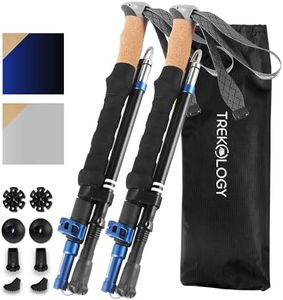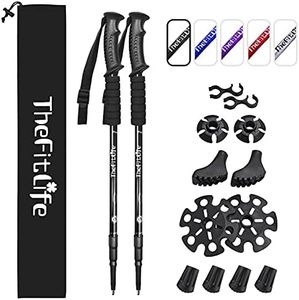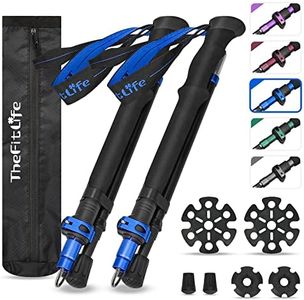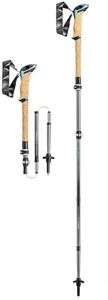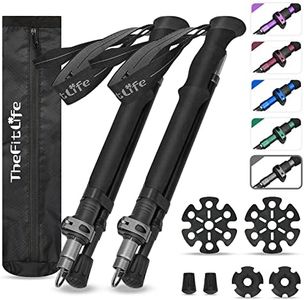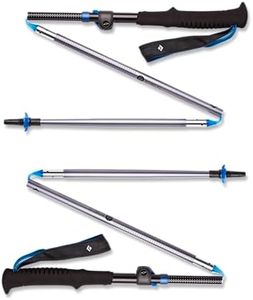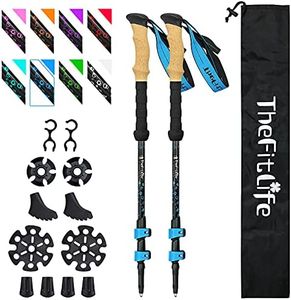We Use CookiesWe use cookies to enhance the security, performance,
functionality and for analytical and promotional activities. By continuing to browse this site you
are agreeing to our privacy policy
10 Best Hiking Poles
From leading brands and best sellers available on the web.By clicking on a link to a third party's website, log data is shared with that third party.
Buying Guide for the Best Hiking Poles
Choosing the right hiking poles can make your hiking experience much more comfortable and enjoyable. Poles help with balance, reduce strain on your legs and joints, and provide extra support, especially on rough terrain or steep climbs. To pick poles that suit you best, it's important to understand which features matter most and how they match up with your hiking style and body type.MaterialThe material of hiking poles mainly affects their weight, strength, and cost. The most common options are aluminum and carbon fiber. Aluminum poles are generally a bit heavier but are very durable and can withstand rough handling. Carbon fiber poles are lighter, which is great for long treks, but they can be more prone to cracking under harsh impact. If you do casual hikes or value durability, aluminum is a solid pick. For long-distance hiking where weight matters, carbon fiber is worth considering.
AdjustabilityAdjustability refers to whether the poles can change in length. Adjustable poles are versatile, letting you adapt their length for different terrains (shorter for uphill, longer for downhills) or share them with others. Fixed-length poles are usually lighter and simpler, which some people prefer for speed or travel. If you often tackle diverse terrain or want an all-purpose pole, adjustable is best. Fixed-length works if you always hike similar trails or want the lightest option.
Grip MaterialThe grip is the handle section you hold, and the material affects comfort and grip, especially over long hikes. Common grip materials include rubber, foam, and cork. Rubber provides good insulation and shock absorption but can feel sweaty in hot weather. Foam is soft and comfortable, wicking away moisture. Cork is a favorite for its natural feel, comfort, and ability to handle sweat well over time. If you hike in mixed climates, cork or foam is good; for cold or wet areas, rubber is more insulating.
WeightWeight refers to how heavy each pole is. Lighter poles are easier to swing and carry, making a difference on long hikes. But lighter poles may sacrifice some durability or stability. Heavier poles can handle tough terrain and rough treatment better. If you do long or fast hikes, look for lightweight options. For rough trails or if you use poles for extra support, consider slightly heavier, sturdier models.
Locking MechanismThe locking mechanism is how an adjustable pole stays fixed at the desired length. Typical types are twist locks and lever (flip) locks. Twist locks are sleeker and less likely to snag, but can be tricky to tighten in wet or cold conditions. Lever locks are quick and easy to use, allowing swift adjustment even with gloves. For convenience and reliability, lever locks are often preferred, especially if you adjust your poles regularly.
Shock AbsorptionSome hiking poles offer built-in shock absorption—usually a spring mechanism—to lessen the impact on your wrists and arms, especially downhill. These are beneficial for people with joint issues or those doing steep descents. However, shock-absorbing poles can be a bit heavier and may feel bouncy. If you have sensitive joints or hike on rocky, steep trails, shock absorption is worth considering. If you prefer a firmer feel or want the lightest pole, you might skip this feature.
Basket and Tip TypeThe basket is the disc near the bottom of the pole, while the tip is what contacts the ground. Small baskets are ideal for regular hiking because they don't get caught in underbrush. Larger, snow baskets are much better in snowy conditions for extra support. Tips are usually carbide for grip on rocks, and often come with rubber covers for extra versatility. If you hike on regular trails, a small basket and carbide tip are best. For snow or mud, look for larger baskets.
